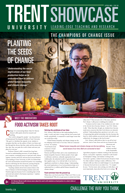 New Trent University Report CardFOR IMMEDIATE RELEASE Highlights Strengths in Student Experience: Top-of-Class Grad Employment and Student Engagement Accountability and benchmarking key objectives in new document From the Board of Governors' Meeting – Friday, February 23, 2007, Peterborough At today's Board of Governors' meeting, Trent University’s Report Card for 2007 was shared, a brand new benchmarking tool to track the University’s performance in key activity areas over time. Trent is committed to transparency and accountability. The public Report Card is a Trent-led initiative, voluntarily created to enable both the University and its stakeholders to assess annual progress against its strategic plan. “It is hoped that enhanced data tools like this Report Card will allow students and their parents to make informed decisions,“ said Trent University president Bonnie Patterson. “These decisions will no doubt draw on information about how many of our grads get jobs, the size of our classes, and exceptional student satisfaction rates.” The Report Card follows the framework based on the Kaplan and Norton scorecard developed in the 1990s. It views the institution from four perspectives: Student and Alumni Outcomes (Client Perspective); Commitment to our Employees (Human Resource Perspective); Revenue Allocation and Fiscal Health (Financial Perspective); and Academic Mission (Vision and Values Perspective). Each indicator is assigned a grade and a target using the strategic plan goals as the benchmark. Highlights of the Report Card 2007:AFFIRMING THE CENTRALITY OF THE INDIVIDUAL STUDENT An Exceptional Educational Experience: The results from the 2006 National Survey of Student Engagement* (NSSE) indicate that Trent University is performing above its Ontario peers in each of NSSE's five cluster areas of student engagement. • 85% of first year students feel that the quality of their entire educational experience was good or excellent versus only 79% for the Ontario average. While 91% the graduating class of 2006 felt they had a good or excellent educational experience versus the 78% at other Ontario universities. • When graduating students were asked if they would go to the same university again, a resounding 88% of Trent's 2006 graduating class indicated they would choose Trent again, while only 76% at other Ontario universities would go to the same university in Ontario again. *All Ontario universities participated in NSSE, which surveyed over one million students in North America. PREPARING STUDENTS FOR SUCCESS IN LIFE Top-of-class Employment Rates: The Ontario University Graduate Survey from 2002 conducted by the Ministry of Training, Colleges and Universities and the Council of Ontario Universities, indicates that Trent’s graduates are excelling in the labour market. • Four out of every five survey respondents indicated that they had found a job related to their field of study. • Trent graduates have an overall employment rate of 95% six months after graduation. Programs with full employment rates include Physical Sciences such as Chemistry, Biochemistry and Physics and Humanities, as well as Biology. VALIDATING TRENT’S ACADEMIC MISSION & VALUES Outstanding Student-to-Faculty Ratios and Small Class Sizes: • Student-to-teaching ratio at the Peterborough campus has decreased from 22.1 to 1 in 2003-04 to 21.9 to 1 for 2005-06. In Oshawa, the student-to-teaching ratio is even lower at 15.8 to 1. • In 2005-06 academic year 45% of first and second year lectures were taught in the 1-50 class size range, while 90% of first and second year labs, seminars and tutorials in the 1-40 class size range. • In 2005-06 academic year 85% of third and fourth year lectures were offered in the 1-50 class size range, while 79% of labs, seminars and tutorials were offered in the 1-19 class size range and 19% of labs, seminars and tutorials were offered in the 20-40 class size range. Leading the Way in Research Grants: • In 2005-06 Trent University increased the amount of cash awards received from external funded research by 32% over 2003-04 levels. Overall, the University was awarded approximately $13.5 million and this figure is up from 2003-04 allocation of $10.2 million. The average award per full-time faculty member now exceeds $55,700 per year and this is up by 29% over 2003-04 levels. AREAS FOR IMPROVEMENT The Report Card identified key areas for renewed attention and focused planning, including retention rates and entering averages. • Retention from year one to year two ranged from 81.7% to 88.1% for the cohort classes of 1998 to 2006. In 2006, year one to year two retention sits at 85% for the Peterborough campus and at 88% for the Oshawa Campus. • Currently, 38% of new secondary school students enter Trent with a grade point average greater than 80%. Trent has set a goal of 45% entering with greater than 80% by 2010-11. The Report Card will allow the University to effectively deliver its mission by focusing its academic and administrative planning on areas where the institution scored lower. The full Trent University Report Card can be viewed at www.trentu.ca/oirsp/accountability.php. -30- For further information about Trent University’s Report Card 2007, please contact: |
































